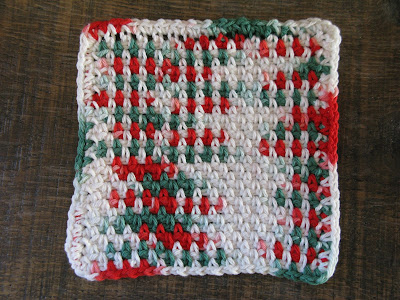I bought a big ball of Bernat Handicrafter cotton yarn in Holidays Ombres to make cork hot pad covers for Christmas. I wrote about those here if you missed it.
There was quite a bit of yarn leftover after making only four hot pad covers. I had read about "colour pooling" using variegated yarn and the linen stitch or moss stitch as it is also called. I was intrigued by the idea of letting yarn create a colour pattern. I thought it might be fun to make a few dishcloths and try my hand at colour pooling using this yarn.

Successful colour pooling patterns vary depending on the yarn, hook size and tension. It requires experimentation to find a starting chain that magically works.
I tried a starting chain of 34 ... no pooling just small patches.
I tried a starting chain of 30 ... still no pooling just bigger patches.
Then I tried a starting chain of 32 ... finally a pooling pattern XX
It really is very cool to create little dishcloths with a cross pattern. For me the magical number was 32, but for you it might be different. Experiment ... it's all part of the fun.
I made four dishcloths with clear XX patterns, two with random colour patches and one more smaller cloth to use up the rest of my yarn. I made another dishcloth in red (also from my stash) to make four gift bundles. These have been put away for next Christmas - handy hostess gifts.Hook size 5.0 mm
Red cotton yarn starting chain = 34
Border = linen stitch
32 was my magical number ... experiment as results may vary.
I thoroughly enjoyed playing with Colour Pooling. Get some variegated yarn and give it a go. You won't be disappointed if you do.
Be the first to comment - click on No comments: below






Very fun, Beth. I find that using the Bernat Handicrafter yarn and knitting a 40 stitch 1x1 rib gives me a similar kind of pooling.
ReplyDeleteFor people who want to avoid colour pooling, the trick is to use two balls of yarn and alternate rows between the two.
Thanks for the tip. I expect it applies to crochet as well as knitting.
Delete